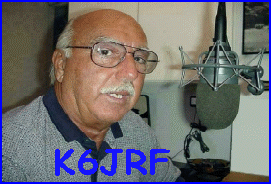
|
K6JRF's Page formerly W6FZC HiFi SSB Audio with the Yaesu FT-1000D HF Transceiver |

|
(Updated: Feb 26, 2015)
|
=== My FT-1000D For Sale ===  1) Filters and capacitors replaced as detailed in Menu #1; 2) Vox mods for the "male voice" as detailed in Menu #5; 3) Improved cooling mods as detailed in Menu #6; 4) Replaced 455Khz filter w/ CMF as detailed in Menu #7; 5) Flattened main receiver response as detailed in Menu #8; 6) Improved Tx monitor in 2nd Rcvr as detailed in Menu #4a; 7) Flattened 2nd Rcvr audio response as detailed in Menu #4b; This is a ONE-OF-A-KIND FT1000D so if you're interested in clean wb Tx and Rx audio, this is the rcvr for you! This was the first Yaesu HF radio to be modified for ESSB. Be sure to read the details in the next section b/c this radio showed that a Yaesu radio could be an ESSB player. The picture shows how it looks today; no dents, some minor scratches and no smoking "odors"! The rcvr and transmitter operates perfectly! Comes with the following items; AC Pwr Cord, MD-1 Desk Mic, MH-1 Hand Mic, Original Yaesu Filters (4), Owners Manual and Service Manual. Price is $1300. Will ship in the original box via UPS Ground to any contiguous US destination. |
|
-------- Yaesu and Extended SSB [ESSB] Audio --------- Introduced back in the late 80's, the Yaesu FT-1000D was a sensation with DXers, Contesters and the general Ham public. Over the years it has proved to be very reliable and rugged radio, surviving many DX-expeditions and most anything else thrown at it.I purchased mine in 1993 and it has been 'down' just one time, with ohmic contacts in the changeover relay and some 'blown' switching diodes on the Low Pass Filter Board. About a year ago (1998), I got bit by the hifi audio bug (later renamed to "ESSB") thanks to people like W2ONV (alas a SK) and VE6CQ. What's funny about this, I said I'd never get interested in extended audio because it didn't make sense! Since I had this great radio as a starting point, I thought why not use it? It should produce excellent sounding audio since it has very low distortion products and its SSB audio was good, however a bit narrow. With some new filters, a few audio part changes and carrier offset adjustments, I should be in business. I was right! What came out of this experiment was a radio with pristine audio plus a radio whose receive bandwidth was not any more than it was with the stock Yaesu filters at the 60dB point (InRad 715 and 716 filters)! At the time this project was started (1998), Yaesu was NOT visible on the ESSB radar. Most ESSBers were using Kenwood radios which already had introduced DSP into their products. With that as a backdrop, I undertook making the FT1000 ESSB capable w/o DSP. Using my EE design experience, I started to analyze the circuits using Spice. I could see, by inspection, that the circuit values caused the severe frequency rolloff which was confirmed by Spice. It quickly determined that most all of the audio (mic, preamp, speaker audio) and IF ckts were severely rolled off, intentionally so. It also showed what values were needed to make the circuits attain wb audio. The easy part, for me, was now done. The next hurdle was the lack of suitable filters for the radio. I contaced George, W2VJN (former owner) at International Radio and convinced him that these new filters would be a saleable product. So using my design specs, InRad developed the required filters, namely the 2.9Khz @ 8.215Mhz (#716), 2.9Khz @ 455Khz (#715), 6Khz @ 8.215Mhz (#710) and a CMF 6Khz @ 455Khz. I also wanted all filters to plug-in where possible, so a versatile filter mounting board was designed that allowed all of the newly developed filters to be used in the FT1000. Needless to say, the ckt changes plus the filters did the "job" as the picture shows. Taken by Rick, VE6CQ directly "off-the-air" using his wb Kenwood rcvr.
It appears that this information was lost. Others are taking credit for something which could not have been done without the "parts" arsenal and ckt analysis techniques developed here. So now you know what came first . . . the FT1000 truly was the chicken and the egg! Use the information here to make your FT1000 an ESSB performer. After investigation into the new FT-2000, I found that it employs DSP so the Rx channel (and Tx) can be opened to 4Khz without additional filters. A nice feature indeed. But other changes (Tx audio) are needed and those will be reported here on the FT-2000 ESSB pages. Click now to see the current progress. |
|
The information on the following pages centers around the FT1000 but there is also much general techniques for attaining
improved SSB audio.
|
|
This room was
remodelled recently and the goals were to make it clean, comfortable, well lighted
and organized, all of the things that the former studio was not! Also made sure to have lots of
120 Vac outlets. To that end, a new service line was added which makes 36 outlets available! The studio is
also wired for 240Vac which powers all radios and linear amps. The air conditioner was just added last month. Wonder why I waited so long?? It makes radio operation a pleasure on these hot summer days. |
 click for more pictures |
 click for more pictures |
The desk lineup
shows; audio rack with five (5) studio grade audio processors; Technics 40W audio amp; Yaesu FT1000D,
Yaesu YO-301 monitor scope, Kenwood TS-711 VHF transceiver. In front of the YO-301 is a Samsung Sens 810 notebook
computer. Second tier shows; Nye-Viking wattmeter, HyGain HDR300 rotator, TNC packet radio, Ameritron AL-572 linear amplifier. Just right of the desk is the Wyse Model 75 monitor for the packet cluster system. This sits on top of a home brew 8877 linear amplifier. |
| This is my completed FT-1000D which doesn't look any different than before the changes! The unit in front of the radio is a Sony MZ-R55 minidisk recorder. Its small size, which I thought would be a problem, turned out to be advantageous. As you can see, the recorder is attached to my audio rack via about five (5) feet of double shielded cable. In use, it's a simple matter to pull the unit out, press the 'record' button to make an off-the-air recording and then play it back. When not in use, it stores nicely under the radio, cables and all! |
 |
 |
My current audio
equipment. Starting from the top; 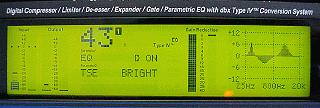 The DDP equalizer screen with its 'visual' frequency display! |
|
Current antennas: The
Cushcraft XM240 40mtr beam has 2 els on a
24' boom. It's light, has low wind area and and has good SWR bandwidth (1.5:1 = 170Khz). The Create 75mtr dipole is 57' long with loading coils and capacitive hat. 1.5:1 SWR bandwidth is 40Khz. The 20mtr beam has 4 els on a 41' boom designed by me using K6STI's Yagi Optimizer (YO). The forward gain is high for this short boom length which results in a low feed impedance and limited SWR bandwidth than a looser coupled beam. Great low angle takeoff because of its height. The 2mtr antenna is a Hustler G7 antenna with 7dBd gain. All antennas are mounted on unique coax standoffs which, while holding the coax, serve as antenna mounts at each tower section. |

|
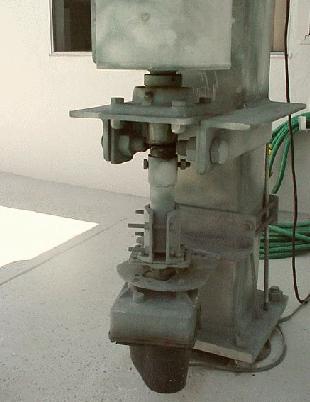 |
The tower
is a 13 year old tubular tower by
US Tower MA-850MDP. This base system,
MARB-850 rotator base, is planted in 6' x 6' x 4.5' of reenforced
concrete and is bolted to the concrete via the four (4) 2 inch diameter bolts. Besides holding the tower,
this allows for easy leveling of the overall structure. Also the base allows the tower to fold over when
it's fully collapsed via the two 2.5 inch triple hardened bolts used as hinges! The five (5) section tower sits on a trust bearing supplied with grease fittings in order to keep rotational wear to a minimum. The bottom plate supports most popular rotators. I've used the HyGain HDR-300 rotator (5000in/lbs of rotating torque) for 24 years with no problems. |
|
The tower system
was purchased with the positive pull-down feature. This feature is very desirable during high winds. If
you've gone though this, then you know what I mean! The reversible 1/2hp motor mounts a 1' pulley driving about 10:1 reduction gear that powers the worm drive box with another 40:1 internal reduction. With all this power, it breaks tangled coax (or anything else) without hesitation! Unfortunately this has happened at least once! The upper spring and pulley assembly takes up slack in the positive pull-down cable that goes directly to a tie point on top of the tower. The tower is controlled by two (2) limit switches that set the highest and lowest points before the motor power is cut off. The control box is basically a junction box for 120Vac and contains reversing and limit switch wiring. The ladder allows you to climb the first section (20') when it's fully collapsed. |
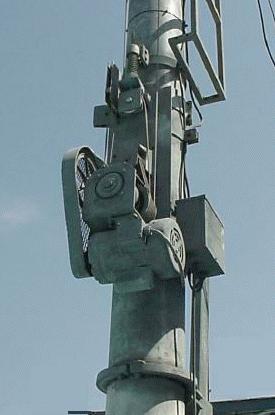 |
 |
This HF
amplifier is just a plain Jane! The Ameritron AL-572
uses four 572B tubes from Svetlana and it outputs 1000W for 65 watts drive and 1400W PEP for 90 watts drive. The amp has 'dynamic
bias' which cuts the tubes off very cleanly been words. Thus the total dissipation is kept remarkably low and, even more
important, the heat buildup in the studio. This is my main amplifier. Incidently, the baffles soften the
air noise pickup in the mic. The baby blocks remind me of my name during senior moments! |
|
This a what
some Hams used to call a 'BIG' amplifier! This home brew amp is a floor unit that houses a single
Eimac 8877 tube. The inset bezels are backlighted and emit a
soft red glow in a darkened room. The top hinges to reveal a massive power supply with 86uF of capacitance and 4400 Volts. It outputs 1500 watts with 60 watts drive. I do not use this amp because, unlike the AL-572, it takes 5 minutes before the filament interlock is ready. I did this to minimize the chance of a filament to cathode short! The tube is 25 years old! |

click for more pictures |
|
Detailed Audio Rack View: The Behringer MIC2200 preamp has a combination tube and solid state amplifier that gives the best of both worlds. A tube preamp in general gives a warmer sound to the audio from the mic. The Behringer EX3200 features sonic exciter/enhancer from 1Khz to 8Khz along with unique bass circuitry to produce warm or 'tight' bass sounds. The Behringer DSP 1100 provides up to 24 parametric EQ channels. Programs are stored in 10 user modifiable programs. The bandwidths are settable from 2 octaves (Q = 0.67) to 1/60 octave (Q = 86.5), levels from +16dB to -48dB. The DDP is a unique audio dynamics processor that employs 24-bit A-D and D-A convs underterer control of a dBx developed DSP chip with a LCD display. A truly marvellous dynamics unit in one increment of panel height. The Alesis MV III generates pro digital reverberation effects using 16-bit linear PCM processing which includes 144 reverbs, 96 delays, and 16 special effects as well as two band frequency equalization. |
 |
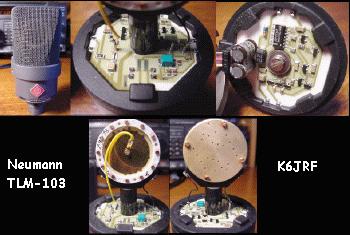
click for detailed picture |
The key element in
audio work is the microphone. There are as many opinions as there are mics, so here we all tend to get subjective. The best
overall mic is probably a 'dynamic' such as the Electrovoice
RE27 or Shure
KSM44. These mics produce audio with little or no coloration. I personally have settled on the 'condenser' style mic because of its high sensitivity (typically 15db more sensitive than a dynamic), and broad pickup pattern. Currently I'm using the Neumann TLM-103. It's a great example of a well engineered and quality manufactured product albeit pricey! The Marshall MXL2003 is a quality condenser microphone that is reasonably priced. The newer "tube" mics such as the MXL V69XM appears to be even a better choice. |
|
. . . Good number of receiver mods for FT1000D by N1EU Send me Visitors since July 3, 2000 |
